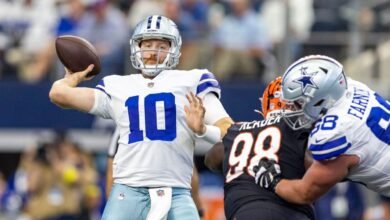Andrew Luck as Stanford GM — What it means for Cardinal and CFB

Former Stanford and Indianapolis Colts star Andrew Luck’s hiring as the Cardinal’s general manager for football looms as an intriguing move in the college football landscape for multiple reasons.
The job comes with a unique range, as Luck will manage aspects of both the football and business sides of the program. For football, Luck will oversee the coaching staff, player personnel staff, recruiting, roster management and student-athlete experience.
On the business side, he will handle duties typically held by NFL team presidents — fundraising, sponsorships, attendance, sales, in-stadium experience and alumni relations.
Here’s a look at what the new role means for Luck, Stanford and the football landscape.
What makes this move unique?
While most major college football programs have a general manager — or some type of personnel director — to oversee the roster, the job in college has always been much different from in the NFL. The head coach is in control in college.
Until Luck’s hiring at Stanford, the GM job has generally been one that reports to the head coach, who typically hires or helps hire the person in that role. The college coach, ultimately, has control of the roster and recruiting decisions.
The Cardinal’s hiring of Luck marks an innovative turn in how football operations work. At Stanford, Luck’s role will be over the head coach on the organization chart, and he’ll work in concert with the coaching staff on personnel decisions.
Luck stressed in a phone interview that he’s excited to work with and learn from Troy Taylor, a veteran coach who just completed his second year at Stanford.
At the core, the move takes the paradigm shift of college players being paid directly through revenue share — expected to come in 2025 — and acknowledges that player acquisition, retention and salary cap management in this new world is complex and important enough that it needs to be managed full time. Just like it is generally done, although not exclusively, by NFL front offices.
Ultimately, with a salary cap, the portal and the sport in a constant state of flux, there was a natural evolution to this type of model. The Cardinal jumped the trend, identified a person with a strong football background who is deeply invested in the program, and made the move first.
What does this mean for Stanford?
The most recent ripple of conference realignment left Stanford on a bit of a West Coast island. It is now in the ACC, playing a league schedule of largely unfamiliar schools. (Other than old rival Cal, which also joined the ACC.)
Stanford finished 3-9 with a loss to San Jose State on Friday and ended up 2-6 in ACC play, 16th place in a 17-team league. The Cardinal finished ahead of only Florida State.
The recent shift in college football to the importance of name, image and likeness money in recruiting and for transfers hasn’t been a positive development for some of the so-called academic schools, as one of their competitive advantages had always been the value of their scholarships being higher than ones from their competitors. There’s also difficulty in taking transfers at some. Luck said Stanford has not been at the forefront of some of these moves, calling it “slow to the draw.”
The allure of the scholarship kept schools such as Stanford, which is No. 4 in the latest U.S. News & World Report college university rankings, in the mix for top prospects with great academics. But the finances available now have somewhat dulled that advantage and given the players in the Cardinal’s limited recruiting pool more factors to choose from in their process.
Luck said he believes in the “value proposition” of a Stanford scholarship but also acknowledges that the program will need to develop creative ways to be more competitive in the marketplace.
The Cardinal haven’t played in a bowl since the 2018 season, although they did decline a bowl invitation in 2020. There were significant portal exoduses before David Shaw’s departure at the school following the 2022 season. Taylor is 6-18 since taking over in 2023.
This will be a huge boost for Stanford from an identity standpoint and likely will be a significant draw in quarterback recruiting. (The Cardinal have a long history of quarterback success, including three quarterbacks drafted since Luck.)
It’s also a way to align Stanford’s recent football success, which included four top-10 Associated Press poll finishes in the 2010s, with the future.
What does this mean for Luck?
There’s a deep affinity from Luck for Stanford. He met his wife, Nicole Pechanec, at the school and has roots in the area. “This is home,” he told ESPN.
Luck and his recruiting class came to Stanford in the wake of a 1-11 season as a key fulcrum of Jim Harbaugh’s early tenure. Luck’s affinity for the school is so deep that he stayed an extra year there despite projecting as the likely No. 1 pick in the 2011 draft. (Cam Newton ended up going No. 1 that year and Luck went first the following year.)
Luck appreciated the so-called “Stanford Bubble,” where he was largely ignored on campus, mostly because the regular students there had bigger things to do.
“I wouldn’t say people don’t care about you being a football player,” Luck told me back in 2011, “but they’ve got more important things to worry about.”
Luck relished the Stanford experience, as he rode his bike to class, took a dip in the Hoover Fountain on campus and studied in a hidden room in the library with knight’s armor that he and his friends discovered.
He returned to the university in the fall of 2022 and earned a master’s in education, with designs to coach and teach. He worked as a volunteer assistant coach at Palo Alto High School for two seasons, which rekindled his love for football.
Luck graduated from Stanford in 2012 and got picked No. 1. He ultimately retired from the Colts after battling significant injuries, and he opened up to ESPN’s Seth Wickersham in December 2022 about the physical and emotional tumult that led to the decision.
The return to the Cardinal in some ways always made sense for Luck. He stuck around to earn his degree, came back for another, and was the beacon of an era when Stanford reached the Orange Bowl and Fiesta Bowl with him at quarterback. The Cardinal then played in the Rose Bowl under Shaw in three of the next four years after Luck went to the NFL.
He calls it a “daunting challenge” and “steep climb” to get Stanford back there, something that has invigorated him.
Will this start a trend in college football?
It’s unlikely there will be an immediate influx of general managers put in charge of college football programs.
But in the past few months there has been a quiet power struggle in athletic departments for how football programs will be allocating their revenue share. (At most powerhouses, the so-called “cap number” for football programs is expected to be more than $15 million.) Athletic directors want a say and some oversight, and some coaches aren’t equipped to handle the nuances.
“Athletic directors seem to want this type of model,” a veteran front office member told ESPN. “Head coaches do not. They want the power.”
Some programs have brought in consultants to figure out NFL-like systems to manage the cap. Many programs have visited NFL franchises to crib ideas about how roster management works at their level.
Stanford in many ways is acknowledging what others are tiptoeing around — there’s a need for someone other than the coach to manage everything within the program. There are a handful of NFL franchises where the coach has complete power, and it only makes sense that college programs will get there. (Especially considering player acquisition in college is more complex than in the NFL, which is choosing from a much more finite pool.)
But with coaches at traditional powerhouses needing to give up power for this to work, this college front office trend is more likely to come in a trickle, not a hailstorm.
Source link



